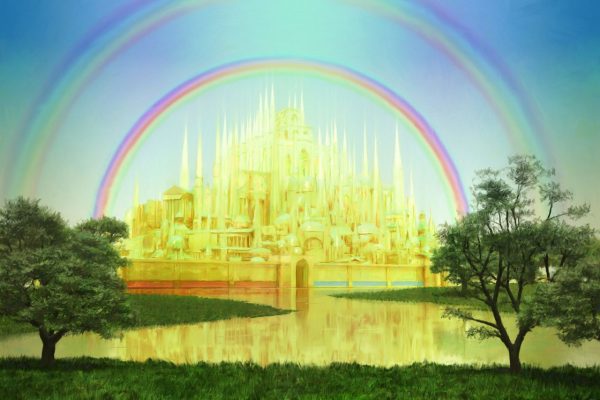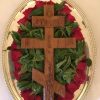It is not an unusual question. Sometimes it is asked with all the freshness of a child, other times with the anxiety of the old. It is not a question that admits of easy answers, nor a question for which language is sufficient. The cynic says, “Nobody knows.” That attitude falls short of the fullness of human experience. There are stories. There are also things that point and make suggestions. There is, also, a pattern of reasoning and seeing that stands beside the various witnesses that have come down to us. A pattern of particular note is the statement that “the Old Testament is shadow, and the New Testament is the icon of the age to come.” This idea is stated plainly in both St. Maximus the Confessor (East) and St. Ambrose of Milan (West). It represents part of the primitive consensus of the Church, a foundational way of seeing the world and the nature of our spiritual life.
The notion is simple: the age to come (heaven) is the true Reality, towards which everything else can only point. This does not deny that what we now know is “real.” Instead, it says that it lacks something in its reality. It’s real, but not completely so. Putting this into words is nearly impossible. However, it gets put into stories, and the stories have enough commonality to suggest that they share a common experience.
Consider these passages:
At that time his voice shook the earth, but now he has promised, “Yet once more I will shake not only the earth but also the heavens.” This phrase, “Yet once more,” indicates the removal of things that are shaken—that is, things that have been made—in order that the things that cannot be shaken may remain. Therefore let us be grateful for receiving a kingdom that cannot be shaken… Hebrews 12:26-28
The earth (the created universe as we know it) is such that it can be “shaken.”
“…as we look not to the things that are seen but to the things that are unseen. For the things that are seen are transient, but the things that are unseen are eternal.” (2Cor. 4:18)
The reality that we see is “transient,” it “passes away.” There is, however, a Reality (the unseen) that is eternal. It is this that cannot be shaken. There is a relationship between the two. When we think of the Incarnation of Christ, we see not the change of the material world (Christ’s flesh is human flesh). We see that which cannot change (the Divine) united to that which changes (the human). It is that which changes that is, in the end, transformed.
So is it with the resurrection of the dead. What is sown is perishable; what is raised is imperishable. It is sown in dishonor; it is raised in glory. It is sown in weakness; it is raised in power. It is sown a natural body; it is raised a spiritual body. If there is a natural body, there is also a spiritual body. Thus it is written, “The first man Adam became a living being”; the last Adam became a life-giving spirit. But it is not the spiritual that is first but the natural, and then the spiritual. The first man was from the earth, a man of dust; the second man is from heaven. As was the man of dust, so also are those who are of the dust, and as is the man of heaven, so also are those who are of heaven. Just as we have borne the image of the man of dust, we shall also bear the image of the man of heaven. 1Cor. 15:42-49
This pattern, a movement from the less-real to the truly-real, from the transient to the eternal, from the shakable to the unshakable, is the same pattern that we see referenced in St. Maximus and St. Ambrose. It is the pattern that is common to typology and patristic allegory.
Of interest to me is how this understanding preserves the integrity of the “lesser” things. The shadow is not abolished by the icon, nor the icon by the Reality itself. In Christ’s word, they are “fulfilled.” It is a pattern that can guide our thinking about things that are beyond us.
An example worth considering can be seen in the topic of male and female. Few things are stated as clearly in the tradition as this particular pattern. Genesis states that God made humankind “male and female.” Jesus Himself focuses our attention on that specific statement when teaching about the nature of marriage. We may presume that the pattern exists (or may be seen) first as shadow.
That shadow is described in the opening chapters of Genesis. We are given interesting information. The two (male and female) have the reality of being “one flesh” (rather than as two utterly distinct realities: one does not exist without the other.) All of the commandments in Genesis (be fruitful; multiply, govern, increase, etc.) are all given to “you plural” (male and female). Also, we are told about the first sin and the role of male and female within that action. The consequences fall upon both of them together.
The shadow of male and female continues throughout the Old Testament – in the Law (particularly in the laws governing marriage and family) – as well as in the prophets (where the image of Israel as a spouse is introduced). Perhaps most striking of all, the first hint of redemption (and Messiah) are seen within the context of male and female in the promise of a “seed” (offspring) who will crush the serpent’s head. (Gen. 3:15)
The shadow passes to icon in the pages of the New Testament. Matthew’s gospel opens with a genealogy, moving then to the birth of Christ. St. Luke opens with the Annunciation and the birth of Christ, followed by a genealogy. A birth (in which is gathered up the promise of Genesis) is the New Testament’s introduction of the Icon. The story of Israel’s deliverance is rooted and fulfilled in the “yes” of a woman, only, this time, the role of “husband” (in some sense) is fulfilled by God Himself.
The New Testament pulls the curtain from the icon throughout its text. The image of the marriage feast, prominent in the parables of Jesus, are revealed in St. Paul to be pointing towards the relationship between Christ and His Church. Just as there is no Adam without Eve, no male without the female, so Christ is not without His bride, the Church. It might strain the ears of some to hear that Christ is “without” anything (such is the blindness wrought by Protestant interpretations of Scripture). But St. Paul, working from the given that the woman is the “body” of the man (“bone of his bone and flesh of his flesh”) teaches that the Bride of Christ, the Church, is the Body of Christ. And not just that the Church is the Body of Christ, but that Christ is the “head” of the Church (as he will say elsewhere that man is the “head” of the woman). Even so, shockingly, he says:
The eye cannot say to the hand, “I have no need of you,” nor again the head to the feet, “I have no need of you.” (1Cor 12:21)
The “whole Adam” is the human race. Christ is the Second Adam, and the “whole” Second Adam includes Christ and His bride, male and female (neither of which disappears into the other). Modern individualism has largely destroyed the Biblical understanding of Church, replacing it with an institutional interpretation in which it becomes a mere fellowship. However, the reality abides. The New Adam and His bride exist among us as icon of the age to come in which the fullness of that union will be made manifest.
As we look towards the age to come, those who mistakenly take St. Paul’s statement that there is “neither male nor female in Christ Jesus” to intimate a disappearance of gender, take up the notion of the abolition of the past, contradicting everything that we know. Instead, we must understand that what passes away is that which is less, that is, a lesser reality of male and female. What remains and is unshaken is a fullness and greatness of male and female compared to which what has gone before pales.
Mary is “more woman” than Eve, an iconic fulfillment of which Eve was but shadow. The Bride of Christ (and the brilliance that she shall be) gathers in the Mother of God and is more like her than like Eve. The greatness of Mary that so scandalizes some is simply an expression of what is being revealed in her. It is in this direction (lesser to greater) that we should turn our hearts when we consider these things.
By the same token, it is of note that Christ’s primary revelation within the Church comes in the Divine Liturgy, the marriage feast of the Lamb. There, the Bridegroom, together with His Bride, enter the marriage chamber in a communion of Divine Life. That we frequently lose sight of Christ as Bridegroom and the Church as Bride says much about our own distractions and distortions. The prayers of the Church constantly invoke the language of our common life, remembering the Theotokos and all the saints, reminding us that our communion is in the totality of Christ, in behalf of all and for all.
What is heaven like? It is something like what we already know, but not in the way we know it. Adam and Eve of the Garden are like the Bridegroom and the Bride, but you do not see the former until you see the latter. Those who begin to see and understand the Eucharist, and the risen Christ revealed in that feast, begin to see everything else in a different light, and under the dawning rays of the age to come, the outline of what they shall be.















